Notes: Dinas was situated on the London & North Western Railway’s (LNWR) Menai Bridge – Afon Wen line, which opened in stages between 1852 and 1871. The section of line at this point had originally been opened by the Carnarvonshire Railway (CR), but from the start it was operated by the LNWR, being formally absorbed in March 1869. Between Penygroes and Caernarfon, the CR line used some sections of trackbed of the earlier 3ft 6in gauge Nantlle Railway, which opened in 1828, and was absorbed into the CR in 1865. This was a horse drawn tramway, built to transport slate from Nantlle to the quay at Caernarfon, but from 1856 onwards, it was known to have carried passengers between Penygroes and Caernarfon.
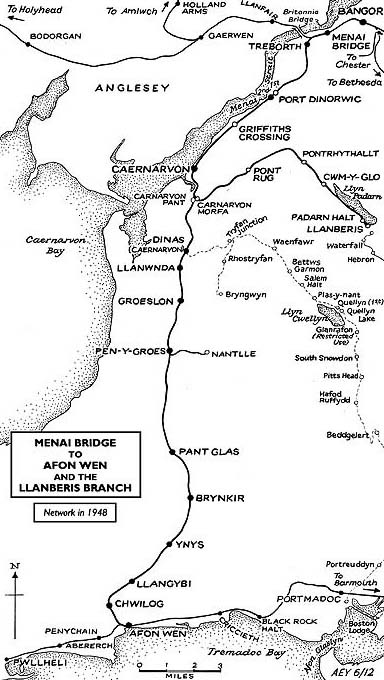 |

|
Webb-type rame and was located at the mid-point of the up platform.
The LNWR down platform (Afon Wen direction) was, in effect, an island platform as the NWNGR terminated on its eastern side. Whilst the LNWR side was an actual brick-faced platform the NWNGR line was at ground level, its rails ballasted up to rail level with cinders. Between the LNWR and the NWNGR lines, towards the southern end of the platform, was a single-storey stone station building with a pitched roof of slate. The building was the property of the NWNGR but it provided passenger facilities for both lines.
| On the eastern side of the NWNGR line was a goods shed which served the NWNGR. To its south were sidings of both narrow- and standard-gauge lines at which goods were exchanged between the two systems. Located between the LNWR and the NWNGR lines at the north end of the station stood a two-storey stationmaster’s house constructed of brick. |
 |
The NWNGR also passed beneath T’yn Llan. On the south side of the lane the NWNGR had an engine shed and facilities for the storage of passenger coaches.
At the time of opening Dinas Junction was served by LNWR trains running between Afon Wen and Bangor and by NWNGR trains running to and from South Snowdon. In 1893 the passing loop on the LNWR line was extended. The Bradshaw timetable for December 1895 showed fourteen Monday to Friday and twenty Saturday departures from Dinas as in the table below.
Up direction (northbound) December 1895 |
Destination |
Down direction (southbound) December 1895 |
Destination |
8.14am |
Llandudno |
5.50am |
Afon Wen |
9.20am Saturdays only |
Carnarvon |
6.00am |
Snowdon |
12.09pm |
Bangor |
7.45am Saturdays only |
Bryngwyn |
2.37pm |
Bangor |
10.00am |
Afon Wen |
5.25pm |
Bangor |
10.05am |
Snowdon |
7.49pm |
Bangor |
12.50pm |
Afon Wen |
| |
|
12.53pm Saturdays only |
Bryngwyn |
| |
|
3.05pm |
Afon Wen |
| |
|
3.10pm |
Snowdon |
| |
|
4.55pm |
Afon Wen |
| |
|
5.00pm Saturdays only |
Snowdon |
| |
|
6.55pm Saturdays only |
Afon Wen |
| |
|
7.00pm Saturdays only |
Snowdon |
| |
|
8.11pm |
Afon Wen |
In July 1912 Dinas was renamed Dinas Junction. The NWNGR was not a financial success, especially after an abortive attempt had been made to extend the line to Porthmadog by creating a new section of railway and using an existing line (the Creosor Tramway). Passenger services were suspended at the end of 1913, and on 1 November 1916 the line closed.
 |
On 31 July 1922 the NWNGR became part of the Welsh Highland Railway (WHR) which also took over the Croesor tramway and built a line from it to Rhyd Ddu via Beddgelert. The line to Porthmadog via Beddgelert opened for traffic on 1 June 1923. From that time passengers could travel between Dinas Junction and Porthmadog. Some through services did operate, but a change of train was usually required at Beddgelert.
|
By July 1922 Dinas Junction had fourteen Monday to Saturday departures on the LNWR line as shown in the table below. The WHR service was not included in Bradshaw, but a service had commenced on 31 July 1922 of two trains in each direction.
Up direction (northbound) July 1922 |
Destination |
Down direction (southbound) July 1922 |
Destination |
7.48am |
Bangor |
9.22am |
Afon Wen |
8.31am |
Carnarvon |
11.59am |
Afon Wen |
10.21am |
Bangor |
12.52pm |
Afon Wen |
11.55am |
Bangor |
4.13pm |
Afon Wen |
2.41pm |
London Euston |
5.31pm |
Afon Wen |
4.57pm |
Bangor |
7.40pm |
Afon Wen |
6.29pm |
Bangor |
|
|
7.55pm |
Bangor |
|
|
On 1 January 1923 the LNWR was absorbed into the London Midland & Scottish Railway (LMS). Very quickly the WHR found itself in financial difficulty. It had been lightly laid using redundant NWNGR equipment, and the anticipated mineral traffic did not materialise. Passenger numbers were significant only during June, July and August. The WHR went into receivership on 1927. Passenger services were reduced and became summer-only, but the LMS did advertise the WHR as a day out opportunity with through tickets being available. The LMS line remained busy: the summer timetable for 1932 showed nine Monday to Saturday northbound departures and eight Monday to Friday southbound, with an additional southbound departure on Saturdays from Dinas Junction as shown in the table below.
Up direction (northbound) Summer 1932 |
Destination |
Down direction (southbound) Summer 1932 |
Destination |
7.46am |
Bangor |
7.19am |
Afon Wen |
8.33am |
Bangor |
9.35am |
Afon Wen |
10.05am |
Bangor |
11.10am Saturdays only |
Afon Wen |
11.55am Saturdays excepted |
Bangor |
12.25pm Saturdays excepted |
Afon Wen |
12.06pm Saturdays only |
Bangor |
12.44pm |
Afon wen |
2.00pm Saturdays only |
Bangor |
2.41pm |
Afon Wen |
2.40pm Saturdays excepted |
Bangor |
3.22pm Saturdays only |
Afon Wen |
4.55pm Saturdays excepted |
Bangor |
4.41pm Saturdays only |
Afon Wen |
4.59pm Saturdays only |
Bangor |
5.23pm Saturdays excepted |
Afon Wen |
6.33pm |
Bangor |
5.32pm Saturdays only |
Afon Wen |
7.53pm |
Bangor |
7.25pm |
Afon Wen |
9.43pm |
Caernarvon |
10.06pm Saturdays only |
Nanttle |
By 1936 there was only a handful of WHR services running during the summer months. The passenger service was withdrawn completely on 28 September 1936, and a year later goods services also ceased. The WHR station building was then leased by the LMS.
With the end of WHR services passenger numbers at Dinas Junction declined. Without the WHR it no longer justified the suffix ‘junction’ which was removed from 26 September 1938.
With the start of the Second World War on 3 September 1939 services were initially reduced but |
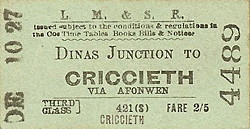 |
they recovered slightly within a few months. In 1940 the WHR was lifted, the materials being recovered to help with the war effort.
In 1947 the passing loop was extended once again so that longer trains could pass at Dinas. One of the drivers for this was the creation of a Butlins camp at Penychain (near Pwllheli) which had been under construction in 1938 and which was commandeered by the admiralty as a naval training base in 1939. After the Second World War the Butlins camp was handed back to its owners, and it opened to paying customers for the summer season of 1947. From the outset special trains were operated.
On 1 January 1948 the Menai Bridge – Afon Wen line became part of British Railways (London Midland Region). Afon Wen station and the Pwllheli – Barmouth line were allocated to the Western Region. The summer 1948 timetable showed Dinas as having only eight northbound and six southbound trains on Monday to Friday, as shown in the table below.
Up direction (northbound) Summer 1948 |
Destination |
Down direction (southbound) Summer 1948 |
Destination |
7.20am |
Bangor |
6.23am |
Afon Wen |
8.51am Saturdays excepted |
Bangor |
9.34am |
Afon Wen |
8.59am Saturdays only |
Llandudno Junction |
12.51pm |
Afon Wen |
11.26am Saturdays only |
Liverpool Lime Street |
3.24pm Saturdays excepted |
Afon Wen |
11.36am Saturdays excepted |
Bangor |
3.44pm Saturdays only |
Afon Wen |
12.00pm Saturdays only |
Manchester Exchange |
4.40pm Saturdays excepted |
Afon Wen |
4.38pm Saturdays excepted |
Bangor |
5.15pm Saturdays only |
Afon Wen |
4.48pm Saturdays only |
Bangor |
6.03pm Saturdays excepted |
Afon Wen |
6.04pm Saturdays excepted |
Bangor |
6.12pm Saturdays only |
Afon Wen |
6.11pm Saturdays only |
Bangor |
8.36pm |
Afon Wen |
7.54pm |
Bangor |
|
|
9.33pm |
Bangor |
|
|
10.37pm |
Bangor |
|
|
On 10 September 1951 British Railways closed Dinas station to all traffic.
On 9 August 1963 H M The Queen boarded a train at Dinas which took her to Criccieth. The station was tidied up with vegetation being cut back and a 6ft strip of tarmac being laid. There was no ceremony at the station as the Queen was on a private visit to her brother-in-law, Anthony Armstrong Jones, Earl of Snowdon.
Passenger and goods services continued to pass through Dinas until 7 December 1964 when the line closed completely, a victim of the Reshaping of British Railways report of 1963 (‘Beeching Report’). The track remained in situ at Dinas until July 1969 after which it was lifted.
The Dinas station site became a depot for the Gwynedd County Council. The station building and goods shed survived as part of the depot, but the space between the platforms on the former LNWR line was filled in and levelled.
 |
In the 1960s an attempt was made to resurrect the WHR but it came to nothing. The idea did not go away, however, and in 1989 real progress was made when the Ffestiniog Railway made a bid for the WHR trackbed. In 1995 the WHR (Transfer) Light Railway Order gave the FR authority to acquire WHR assets, and the Millennium Commission awarded a grant of |
£4.3 million to construct a line from Caernarfon to Rhyd Ddu. Work began on the construction of a ‘new’ WHR between Caernarfon and Dinas in 1997 using the trackbed of the former LNWR line, with a view to extending along the original WHR to Porthmadoc.
The section of line between Caernarfon and Dinas opened to passenger services on 11 October 1997. Laid as a single line the ‘new’ WHR was provided with a run-round loop at Dinas on the site of the former LNWR line, and two platforms were constructed. The original NWNGR station was brought back into use, and the goods shed was developed as a museum. Carriage sheds were built on the site of the former sidings area, east of the line and south of the goods shed. The site of the engine shed on the south side of T’yn Llan was also brought back into use.
On 7 August 2000 the line was extended to Waunfawr, and Dinas became a through station. Further extensions of the line followed in stages with the final section into Porthmadog opening to regular passenger services in 2011.
Tickets from Michael Stewart route map drawn by Alan Young
Sources:
To see the other
stations on the Menai Bridge - Afonwen line click on the station
name: Menai Bridge, Treborth, Port Dinorwic (1st), Port Dinorwic (2nd), Griffiths Crossing, Caernarvon, Carnarvon Pant, Llanwnda, Groeslon, Penygroes, Pant Glass, Brynkir, Ynys, Llangybi, Chwilog & Afon Wen
See also: Nantlle |

old1.jpg)
.jpg)

old10.jpg) Looking north as a WHR train prepares to depart from Dinas in the 1920s. At that time the station was known as Dinas Junction. The train was probably on a Beddgelert service.
Looking north as a WHR train prepares to depart from Dinas in the 1920s. At that time the station was known as Dinas Junction. The train was probably on a Beddgelert service.old8.jpg)
old7.jpg)
old4.jpg)
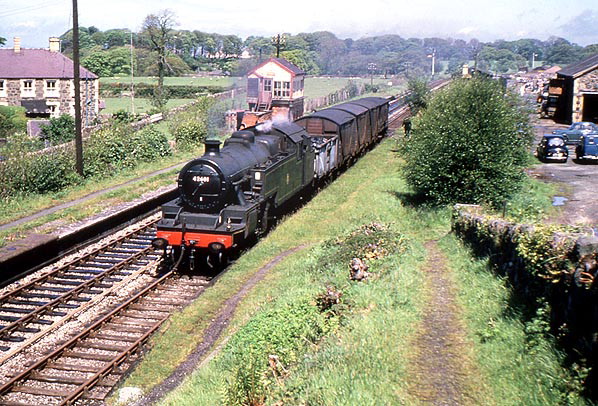
7.jpg)
1.jpg)
 The station building at Dinas seen looking south on 25 May 2012. The original WHR (previously the NWNGR) was to the left of the building. The bridge under which it passed can be seen in the distance. When the 'new' WHR opened to Dinas in October 1997 the line used the trackbed of the former LNWR Menai Bridge - Afon Wen line.
The station building at Dinas seen looking south on 25 May 2012. The original WHR (previously the NWNGR) was to the left of the building. The bridge under which it passed can be seen in the distance. When the 'new' WHR opened to Dinas in October 1997 the line used the trackbed of the former LNWR Menai Bridge - Afon Wen line.






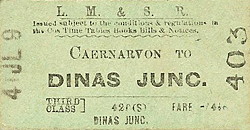
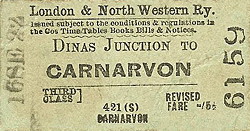

.jpg)
.jpg)
.jpg)

 Home Page
Home Page